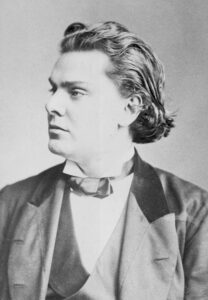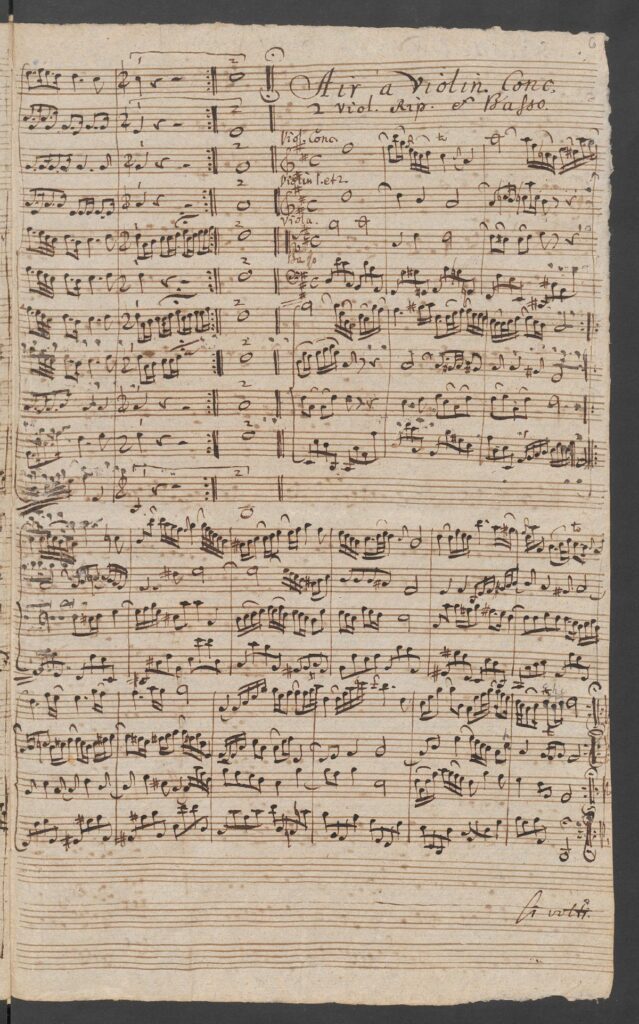English
I played the Air on the G string on the piano.
This piece is called “Air on the G string” because violinist August Wilhelmj arranged the second piece (Air) of Bach’s “Orchestral Suite No. 3 in D major, BWV 1068” for solo violin with piano accompaniment, using only the G string (the lowest string) of the violin. This is why it is called “Air on the G string”.
August Wilhelmi

Why did Wilhelmi arrange it so that it could be played on the G string only?
I’ve never played the violin, but I thought it might be because using only the lowest G string of the violin makes a thicker, more relaxed sound and allows for a smoother expression.
Selecting music
To play this piece on the piano, I first thought about what score to use. There are a lot of piano arrangements out there, but I didn’t want to play Bach’s music with a strange piano arrangement, so I decided to buy the following two scores from a reputable publisher and compare them.
- Arrangement for Piano Solo by Tan Goto (Zen Ongaku Fu Shuppansha) https://www.amazon.co.jp/gp/product/4119114554/
- Arrangement for piano solo by T.A.Johnson (Peters)
https://www.amazon.co.jp/gp/product/4636004000/
When I compared them, I found that the version arranged by T.A.Johnson was closer to the original than the version arranged by Goto, because the multiple voices were organized simply so that it was easier to play on the piano.
What you can learn from Bach’s autographs.
I wanted to refer to Bach’s autographs, so I searched the Internet and found them.
What a wonderful era we’re living in!
I noticed the following points when I checked the Music manuscript.
- Bach’s autographs are relatively clean and easy to read.
- Bach’s autographs are written very tightly, not to waste paper. (That’s a big difference from Beethoven.)
- There are four parts written for each instrument: first violin, second violin, cello, and bass.
– It is often played with harpsichord accompaniment, but the harpsichord part is not written. - I have the impression that Bach did not write slurs in the scores of his keyboard pieces, but the violin part of this piece has slurs written in it.
– So it may be a good reference for articulation when playing Bach’s music on the piano.
Difficulties when playing on the piano
On the piano, the sound decays immediately after the keys are pressed. Therefore, it is not possible to expand or increase the volume of a long extended note like the violin. For this reason, you may want to add nuance to the accompaniment or use pedals to expand the sound, but there are some problems as follows.
- I would like to play the accompaniment (bass line) of this song in a simple way, separating each note.
- If I use too much pedal, the sound will be muddy and the music of Bach’s time(the Baroque era) will be lost.
Also, unless you play multiple parts at the same time, smoothly connecting the notes with your fingers, you will not be able to make it sound like a melody.
This time, I tried to practice without pedals, using only fingers to connect the notes as much as possible. However, during recording, I tried playing without using the pedal and changing the pedal as often as possible. As a result, I decided to play while changing the pedal as often as possible so that the sound would not become muddy.
Impressions after playing
I was so familiar with this song that I had no idea what to do with it, but the more I played it, the more I felt it was a great song. The flowing melody (in the right hand), the bass line (in the left hand) that seems to mark time without hesitation, the chords that change from moment to moment and show subtle expressions, and the well-balanced composition of the song make me feel as if eternal time is flowing without hesitation and the scenery of nature is changing.
Please listen to it on youtube.
https://youtu.be/qtR5H6Iddb0
日本語
G線上のアリアをピアノで弾いてみました。
https://youtu.be/qtR5H6Iddb0
この曲は、バッハの『管弦楽組曲第3番ニ長調 BWV1068』の第2曲(Air)を、
バイオリニストのアウグスト・ヴィルヘルミ(August Wilhelmj)が、ピアノ伴奏付きのヴァイオリン独奏のために編曲した際に、
バイオリンのG線(一番低い弦)のみを使用して演奏出来る様にした事から、「G線上のアリア」と呼ばれています。
アウグスト・ヴィルヘルミ

なぜ、ヴィルヘルミは、G線だけで演奏出来るように編曲したのでしょうか?
自分はバイオリンを弾いた事がないですが、恐らくはバイオリンの一番低くG弦のみを使うと太くゆったりした音が出せて、なめらかな表現が可能になるからでは無いかと思いました。
楽譜選び
さて今回ピアノで演奏するにあたり、まず楽譜をどうしようかと考えました。
色々なピアノアレンジが世に溢れているとは思うが、バッハ様の曲を変なピアノアレンジで弾きたくない。
なので候補として、きちんとした出版社から出ているものが良いだろうと思い、下記の2つの楽譜を買って見比べてみる事にしました。
- 全音楽譜出版社 / 後藤丹によるピアノ・ソロ用編曲 https://www.amazon.co.jp/gp/product/4119114554/
- ペータース社 / T.A.Johnsonによるピアノ・ソロ用編曲
https://www.amazon.co.jp/gp/product/4636004000/
ちょろちょろっと弾き比べてみたところ後藤丹編曲版よりはT.A.Johnson編曲版の方が、ピアノで演奏しやすく、
複数の声部がシンプルに整理されており、原曲に近く、
自分にとってはバッハを弾いている感覚が得られやすいと思いましたので、そちらを弾くことにしました。
バッハの直筆譜を見てわかる事
バッハの直筆譜も参考にしてみたいと思いネットで検索した所、見つかりました。
とっても良い時代です。
直筆譜をみていて気がついた事としては、以下の点でした。
- バッハの直筆譜は比較的綺麗で読みやすい。
- 紙を無駄使いしない様にびっしりと書いている。(ヴェートーベンと大違いだな)
- 第1バイオリン、第2バイオリン、チェロ、ベースの4つの楽器のパートが書かれている。
※チェンバロの伴奏と共に演奏される事が多いがチェンバロのパートは書かれていない。 - バッハは鍵盤用の曲の楽譜には、スラーを書かれていない印象だが、この曲のヴァイオリンのパートにはスラーが書かれている。
※ピアノでバッハの曲を弾く際のアーティキュレーションの参考にもなりそう。
ピアノで弾く場合の難しさ
ピアノは打鍵した後すぐに、音が減衰していってしまいます。
なのでヴァイオリンの様に長く伸ばしている音を膨らませたり大きくする事が出来ません。
その分、伴奏でニュアンスをつけたり、ペダルを使って音を膨らませたりしたい所ではありますが、
- この曲の伴奏(ベースライン)は、一つ一つの音を区切って淡々と演奏したい。
- ペダルを使いすぎると音が濁るし、バッハの時代の音楽らしさが損なわれる。
という問題があります。
また複数のパートをいっぺんに指で滑らかに音を繋げながら弾かないと、メロディーらしく聴かせる事が出来ません。
今回は、練習時には極力指だけで音をつなげて演奏出来るようにし、
録音時には、ペダルを使用しない演奏と、ペダルを細かく踏み替える演奏を試してみました。
結果、ペダル濁らない程度に細かく踏み替えながらの演奏を採用しました。
弾いてみた感想
聞き馴染みがありすぎて想いれのなかったこの曲でしたが、弾いてみれば見るほどなんともいい曲と感じました。
流れる様なメロディー(右手)と、時を淡々と刻むかの様なベースライン(左手)、
刻々と変化してゆき微妙な表情を見せる和音、そして均整のとれた楽曲構成、
まるで、悠久の時が淀みなく流れ、大自然の景色が移り変わって行くようだと思いました。
よろしければyoutubeにてお聞きください。
https://youtu.be/qtR5H6Iddb0
한국어
G선상의 아리아를 피아노로 연주해 봤습니다.
https://youtu.be/qtR5H6Iddb0
이 곡은 바이올리니스트 아우구스트 빌헬미(August Wilhelmj)가 바흐의 ‘관현악 모음곡 제3번 라장조 BWV1068’의 제2곡(Air)을 피아노 반주가 딸린 바이올린 독주로 하기 위해 편곡했을 때 바이올린의 G선(가장 낮은 현)만을 사용하여 연주할 수 있도록 한 사실에서 ‘G선상의 아리아’라고 부릅니다.
아우구스토 빌헤르미

왜 빌헬미는 G선으로만 연주할 수 있게 편곡을 했을까요?
바이올린을 켜본 적이 없지만, 아마 바이올린의 가장 낮은 G현만을 사용하면 굵고 느린 소리를 낼 수 있고,부드러운 표현이 가능해지기 때문이 아닐까 생각했습니다.
악보 선택
이번에 피아노로 연주할 때 먼저 악보를 어떻게 할까 생각했습니다.
여러가지 피아노 편곡이 많다고 생각하지만, 바흐님의 곡을 이상한 피아노 어레인지로 연주하고 싶지 않았기 때문에 제대로 된 출판사의 것이 좋을 것 같아서 아래의 두 악보를 사서 비교해 보기로 했습니다.
- 젠온악보출판사 / 고토 단에 의한 피아노 솔로용 편곡 https://www.amazon.co.jp/gp/product/4119114554/
- 페터스사 / TAJohnson의 피아노 솔로용 편곡
https://www.amazon.co.jp/gp/product/4636004000/
조금씩 연주해 본 결과 고토탄 편곡판보다는 T.A.Johnson 편곡판 쪽이 피아노로 연주하기 쉽도록 복수의 성부가 심플하게 정리되어 있어서 원곡에 가까웠기 때문에 바흐를 연주하는 느낌을 낼 수 있다고 생각해서 T.A.Johnson 편곡으로 연주하였습니다.
바흐의 친필보를 통해 알 수 있는 것들
바흐의 친필보도 참고로 해 보고 싶다고 생각해서 인터넷 검색을 해서 찾아냈습니다.
너무나 좋은 시대군요。
자필보를 확인하고 깨달은 점으로는 다음과 같은 점이었습니다.
- 바흐의 친필보는 비교적 깔끔하고 읽기 쉽습니다.
- 종이를 낭비하지 않도록 빽빽이 쓰고 있습니다.(베토벤과 많이 다르군요)
- 제1바이올린, 제2바이올린, 첼로, 베이스의 4가지 악기의 파트가 적혀 있습니다.
– 쳄발로 반주와 함께 연주되는 경우가 많지만 쳄발로 파트는 적혀있지 않습니다. - 바흐는 건반용 곡의 악보에는, 슬러가 적혀있지 않은 느낌이지만, 이 곡의 바이올린 파트에는 슬러가 쓰여져 있습니다.
– 피아노로 바흐의 곡을 연주할 때의 아티큘레이션의 참고도 될 것 같습니다.
피아노로 연주하는 경우의 어려움
피아노는 건반을 누른 후 바로 소리가 감소합니다.
그래서 바이올린처럼 길게 기르는 소리를 부풀리거나 크게 할 수가 없습니다.
그 만큼, 반주로 뉘앙스를 붙이거나 페달을 사용해 소리를 부풀리거나 하고 싶은 부분이 있지만, 다음과 같은 문제가 있습니다.
- 이 곡의 반주 (베이스라인)는, 하나하나의 음을 구분하여 담담하게 연주하고 싶고
- 페달을 너무 많이 사용하면 탁해지고 바흐 시대의 음악다움이 손상됨
또 여러파트를 동시에 손가락으로 매끄럽게 소리를 연결해가면서 연주하지 않으면 멜로디처럼 들리지 않습니다.
이번 연습 때는 페달을 사용하지 않고 손가락만으로 최대한 소리를 연결해 연주할 수 있도록 했습니다.하지만 녹음할 때는 페달을 사용하지 않는 연주와 페달을 미세하게 바꾸는 연주를 해봤습니다.
그 결과, 음이 탁하지 않을 정도로 세세하게 바꿔 밟으면서 하는 연주 방법을 선택했습니다.
연주한 감상
너무나 익숙한 곡이어서 특히 애착이 있는 곡이라고 할 수 없었지만 연주해보면 볼수록 정말 좋은 곡이라고 느꼈습니다.
흘러가는 듯한 멜로디(오른손), 시간을 담담하게 새기는 듯한 베이스라인(왼손), 시시각각 변화하고 묘한 분위기를 표현하는 화음, 그리고 균형 잡힌 악곡 구성은 마치 유구한 시간이 막힘없이 흘러 대자연의 경치가 변해가는 것 같았습니다.
괜찮으시다면 유튜브에서 들어봐주세요.
https://youtu.be/qtR5H6Iddb0
